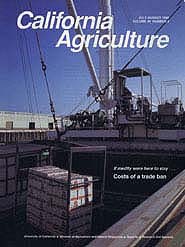All Issues

If medfly were here to stay...Costs of a trade ban
Cover:
If an infestation of the Mediterranean fruit fly triggered a trade embargo of California produce, many commodities would suffer revenue losses, particularly citrus. UC economists estimate that it would cost the state $1.2 billion in Gross State Product and more than 14,000 jobs. Photo courtesy of Sunkist Growers, Inc.
July-August 1995
Volume 49, Number 4
Volume 49, Number 4





